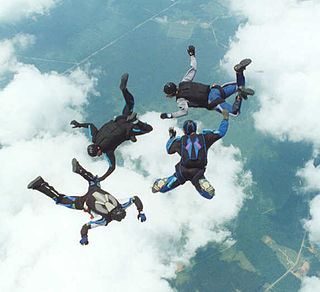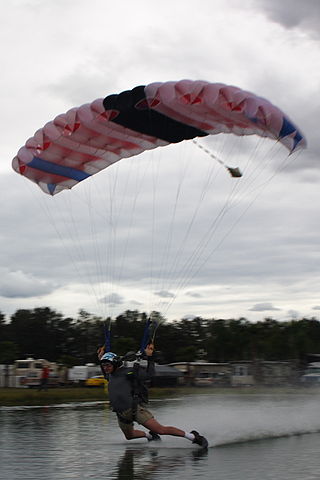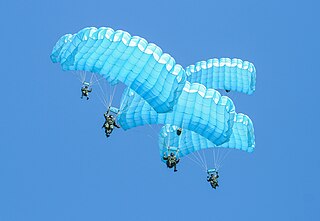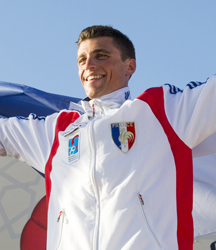This article needs additional citations for verification .(June 2007) |

Accuracy landing is one of the oldest skydiving disciplines, in which skydivers attempt to land as closely as possible to a predetermined target. [1]
This article needs additional citations for verification .(June 2007) |

Accuracy landing is one of the oldest skydiving disciplines, in which skydivers attempt to land as closely as possible to a predetermined target. [1]
Competitive accuracy landing is a team event with 5 persons on each team that takes place over 8 rounds. The team jumps together, generally from an altitude of 900 meters (3,000 feet), although sometimes as high as 1,100 meters (3,600 feet). The score is measured in meters from "dead center". The best score for each round is 0,00 meters (meaning hitting dead center) and the worst score for a round is 0.16 meter (16 centimeters or 6 inches). Scores for each round are added together, and the scores count both as individual scores and as part of the team score. In some competitions only the four best scores count in the team competition.
The target, known as "dead center" is a circle with a diameter of 2 centimeters (a little less than an inch). The disk measures the distance from the edge of the dead center circle to the point the disc is touched, in increments of 1 centimeter (0,01 meters). The accompanying picture shows the electronic disk with the yellow dead center.
Note on dead center size: The 2 cm dead center has been in use from 2007. Previously the dead center was 3 cm and before that 5 cm, and before that 10 cm. The reason for reducing the size of the dead center is to have more separation between the top competitors. If two or more competitors have the same score they do re-jumps until a winner is found. Smaller dead center makes it more difficult and less likely to have many with the same score.

Because jumpers usually land on their feet, most try to touch the dead center mark with the heel of their shoe. After the first 8 rounds are completed, the team competition ends and winners are declared. Based on the individual results, the best half of the skydivers do one individual semifinal jump where the score is added to the individual score. Based on this score the best half of the remaining skydivers make it to the last and final round. If the 3 first places are shared between skydivers with the same score, there are re-jumps to "sudden death". This means that different scores separate the skydiver for each of the first 3 places. In some competitions the organizers choose to use the skydiver with the most dead centers as the better skydiver.
The picture at right shows the final second before landing. The heel is poised over the dead center ensuring this will be the first place the skydiver touches the ground.
The world record has been broken in 2013 by a member of the French Parachuting Team, Thomas Jeannerot. It was during the 4th Dubai International Parachuting Championship at Skydive Dubaï. The new record is now 2 cm in 10 cumulated jumps. It has been validated by the FAI, ( World Air Sports Federation ) in the beginning of 2014.
Show jumping is a part of a group of English riding equestrian events that also includes eventing, hunters, and equitation. Jumping classes are commonly seen at horse shows throughout the world, including the Olympics. Sometimes shows are limited exclusively to jumpers. Sometimes jumper classes are offered in conjunction with other English-style events. Sometimes, show jumping is but one division of a very large, all-breed competition that includes a very wide variety of disciplines. Jumping classes may be governed by various national horse show sanctioning organizations, such as the United States Equestrian Federation or the British Showjumping Association. International competitions are governed by the rules of the International Federation for Equestrian Sports.

Ski jumping is a winter sport in which competitors aim to achieve the farthest jump after sliding down on their skis from a specially designed curved ramp. Along with jump length, competitor's aerial style and other factors also affect the final score. Ski jumping was first contested in Norway in the late 19th century, and later spread through Europe and North America in the early 20th century. Along with cross-country skiing, it constitutes the traditional group of Nordic skiing disciplines.

A parachute is a device used to slow the motion of an object through an atmosphere by creating drag or, in a ram-air parachute, aerodynamic lift. A major application is to support people, for recreation or as a safety device for aviators, who can exit from an aircraft at height and descend safely to earth.

Freeflying is a skydiving discipline which began in the late 1980s, involving freefalling in various vertical orientations, as opposed to the traditional "belly-to-earth" orientation. The discipline is known to have originated when Olav Zipser began experimenting with non-traditional forms of bodyflight. Zipser founded the FreeFly Clowns as a two-person competitive team with Mike Vail in 1992. He was joined by Omar Alhegelan, Charles Bryan, and Stefania Martinengo in 1994. The FreeFly Clowns are also credited with opening the first school to teach freeflying, The First School of Modern SkyFlying.

Sky surfing is a type of skydiving and extreme sport in which the skydiver wears a custom skysurf board attached to the feet and performs surfing-style aerobatics during freefall.

Formation skydiving is a skydiving event where multiple skydivers attach themselves to one another by grabbing each other's limbs or by the use of "grippers" on their jumpsuit while free falling through the sky. The goal of this skydiving program is to build a formation of multiple divers arranged in a geometric pattern.

Wingsuit flying is the sport of skydiving using a webbing-sleeved jumpsuit called a wingsuit to add webbed area to the diver's body and generate increased lift, which allows extended air time by gliding flight rather than just free falling. The modern wingsuit, first developed in the late 1990s, uses a pair of fabric membranes stretched flat between the arms and flanks/thighs to imitate an airfoil, and often also between the legs to function as a tail and allow some aerial steering.

Canopy piloting encompasses several disciplines, all involving the flight of a skydiving parachute.

A radio-controlled glider is a type of radio-controlled aircraft that normally does not have any form of propulsion. They are able to sustain continuous flight by exploiting the lift produced by slopes and thermals, controlled remotely from the ground with a transmitter. They can be constructed from a variety of materials, including wood, plastic, polymer foams, and composites, and can vary in wing loading from very light to relatively heavy, depending on their intended use.

Felix Baumgartner is an Austrian skydiver, daredevil and BASE jumper. He is widely known for jumping to Earth from a helium balloon from the stratosphere on 14 October 2012 and landing in New Mexico, United States, as part of the Red Bull Stratos project. Doing so, he set world records for skydiving an estimated 39 km (24 mi), reaching an estimated top speed of 1,357.64 km/h (843.6 mph), or Mach 1.25. He became the first person to break the sound barrier relative to the surface without vehicular power on his descent. He broke skydiving records for exit altitude, vertical freefall distance without a drogue parachute, and vertical speed without a drogue. Though he still holds the two latter records, the first was broken two years later, when on 24 October 2014, Alan Eustace jumped from 135,890 feet with a drogue.

The United States Army Parachute Team, nicknamed the Golden Knights, is a demonstration and competition parachute team of the United States Army. It consists of demonstration and competition parachutist teams, drawn from all branches of the U.S. Army. Members must demonstrate excellence in parachuting.

Roger Warren Nelson was a skydiver, convicted drug smuggler, and founder of Skydive Chicago, one of the largest skydiving centers in the United States.
Lisa Olsen is a Canadian-American skydiver.
Cheryl Stearns is an American skydiver.

Parachuting and skydiving is a method of transiting from a high point in an atmosphere to the ground or ocean surface with the aid of gravity, involving the control of speed during the descent using a parachute or parachutes.
The men's normal hill individual ski jumping competition for the 2010 Winter Olympics in Vancouver, Canada was held on 12 and 13 February 2010 at Whistler Olympic Park in Whistler, British Columbia. It was the first medal event of the 2010 Games.

Skydive Empuriabrava is the brand that has been commercially operating Empuriabrava Aerodrome since 1985. Since it began operating, its main activity has been skydiving although it also offers photo flights, aerial and tourist advertising, and runs a school of aviation for private pilots.

Rachel Thomas is an Indian skydiver. She was the first Indian woman to skydive from 7,000 ft over the North Pole on 20 April 2002, to commemorate 150 years of the Indian Railways.

Thomas Jeannerot is a French professional athlete in parachuting. He is currently high-level athlete and member of the French Team of Parachuting in the double discipline Accuracy landing and Style.

The women's triple jump event at the 2020 Summer Olympics took place between 30 July and 1 August 2021 at the Japan National Stadium.